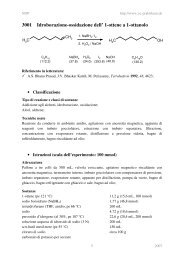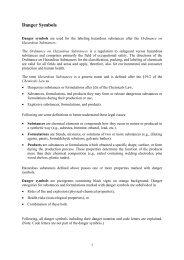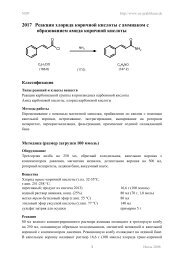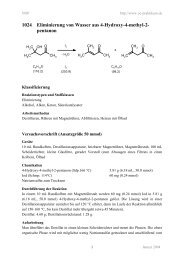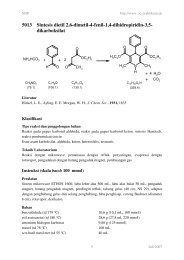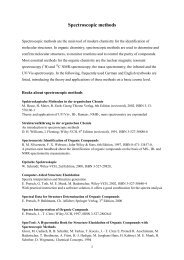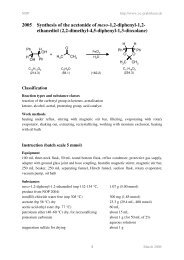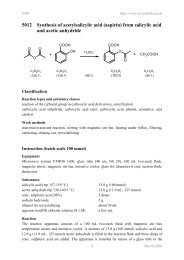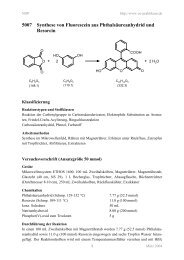Synthesis instructions as PDF file for printing - kriemhild
Synthesis instructions as PDF file for printing - kriemhild
Synthesis instructions as PDF file for printing - kriemhild
You also want an ePaper? Increase the reach of your titles
YUMPU automatically turns print PDFs into web optimized ePapers that Google loves.
NOP http://www.oc-praktikum.de<br />
After 25 minutes reaction time under reflux whilst the microwave program continues to run,<br />
an air or nitrogen flow is introduced with such a flow rate that no single g<strong>as</strong> bubbles are<br />
visible in the bubble counter (if a flow rate meter is present, 5 L/h). A mixture (3-8 mL) of<br />
water, ethanediol and small amounts of product are collected in the collection round-bottom<br />
fl<strong>as</strong>k.<br />
Work up<br />
Once the program is completed, the reaction fl<strong>as</strong>k is placed in a water bath and the oily<br />
contents, which tends to crystallization, is allowed to stir <strong>for</strong> 5 minutes. One then adds 80 mL<br />
water and allows to stir intensively <strong>for</strong> a further 15 minutes. The water is separated from the<br />
ivory coloured solid product with a folded filter paper. The crystallized product traces in the<br />
condenser and in the collection round-bottom fl<strong>as</strong>k are also rinsed out with water and filtered.<br />
Yield of crude product: 18.6 g; mp 50-52 °C; purity according to GC 98%<br />
In order to remove the not converted aldehyde with sodium hydrogensulfite, the crude product<br />
(which can still be wet) is dissolved in 200 mL tert-butyl methyl ether and extracted with<br />
20 mL saturated aqueous sodium hydrogen sulfite solution. The organic ph<strong>as</strong>e is dried over<br />
sodium sulfate. Once the drying agent h<strong>as</strong> been filtered off, the solvent is completely<br />
evaporated on the rotary evaporator with a bath temperature of 40 °C. The bath temperature<br />
should not be higher due to the low melting point of the product. A pale yellow, fine<br />
crystalline solid remains.<br />
Yield: 17.7 g (90.7 mmol, 91%); mp 52-54 °C; purity according to GC 99.8%<br />
The product can be recrystallized from a solvent mixture of tert-butyl methyl ether/petroleum<br />
ether: The product is placed into a 250 mL two-neck round-bottom fl<strong>as</strong>k contanining a<br />
magnetic stir bar. A solvent mixture of 40 mL tert-butyl methyl ether and 50 mL petroleum<br />
ether (40-60 °C) is added. The fl<strong>as</strong>k is set up in the microwave, <strong>as</strong> described <strong>for</strong> the standard<br />
reflux apparatus, and allowed to stir under reflux <strong>for</strong> 2 minutes at 500 W and 55 °C. The clear<br />
solution is cooled in a water bath during the 5 minute ventilation period in the microwave.<br />
The semi-solid crystalline slurry is then allowed to stand <strong>for</strong> at le<strong>as</strong>t a further 15 minutes at<br />
room temperature and then a further 1 hour in the refrigerator. The crystals are filtered off<br />
using a suction filter. The crystallization fl<strong>as</strong>k is w<strong>as</strong>hed 2 times with 10 mL petroleum ether,<br />
thereby w<strong>as</strong>hing the residue onto the filter. The recrystallized product is dried in the<br />
desiccator at reduced pressure.<br />
Yield of recrystallized product: 16.4 g (84.0 mmol, 84%); mp 53-55 °C<br />
After evaporating the solvent of the mother liquor from the recrystallization, a residue of<br />
1.2 g, consisting of 95 % product, is obtained.<br />
Comments<br />
If the reaction is per<strong>for</strong>med only under reflux, but without distilling off the volatile<br />
substances, less than 90 % of the 3-nitrobenzaldehyde is converted to the acetal. Together<br />
with condensing water also some ethanediol is distilled off <strong>as</strong> an azeotrope.<br />
By stirring the reaction mixture with water possible residues of ethanediol and p-toluenesulfonic<br />
acid are removed.<br />
3<br />
July 2005



